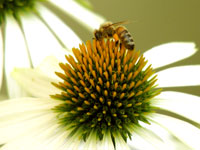
by Linda Wiggen Kraft
It sounds like a Hollywood horror story, but it is real and happening right now. Honey bees are dying by the millions all over the world. Over ten million hives have been decimated since 2006 when colony collapse disorder was identified. Last winter over 30% of the honeybee hives in the US perished. In China crops are being hand pollinated by people since there are no bees to do the pollination. Honey bees which are non native are not the only bees in peril, native bee populations are also decreasing.
We live in a world where one third of food needs to be pollinated; natural fiber clothes need pollination; and plants need pollination to produce seed. We have a serious problem when there aren’t enough pollinators to keep the world alive as we know it.
What does this have to do with the average gardener? Perhaps more than most people think. There is no one definitive cause of the death of honey bees. It appears that multiple factors contribute. Mites, viruses, poor nutrition due to monoculture feeding and transport, and a new highly potent type of pesticides called neonicotinoids are considered the causes of colony collapse disorder. Native bee populations are diminishing due to pesticides & loss of habitat.
There are things gardeners can do to help bees. They are: provide a multitude of nutritious pollen and nectar throughout the growing season; provide habitat for native bees and/or have a beehive, not use toxic pesticides in the landscape, especially neonicotinoids; eat organic foods and urge others to do these same things.
Bees, like people, need a diverse diet to stay healthy. That means different kinds of pollen and nectar from a variety of flowering trees, shrubs, perennials and annuals throughout the growing season. Native bees have evolved with native plants and play an important role in bee feeding and survival.
The new type of pesticides used in agriculture and landscaping of most concern are called neonicotinoids. They are toxic systemic chemicals, which means they go into every part of the plant, including pollen and nectar. They do not break down easily so they stay in the plant the entire growing season. Most agricultural seeds are coated with this chemical.
It is also found in the soil where these seeds are planted. Bees and other insects are exposed to these chemicals over and over as they visit and feed on the plants. Europe has just banned the use of neonicotinoids for two years to address the crisis of bee death.
In the US these chemicals are still being used, often in much higher doses in the home landscape than in agriculture. Injections, sprays, dusts and other ways to apply these chemicals are found in bottles and containers in garden sections and garden center stores.
An example of how these chemicals are used is in maple trees that are injected to stop Japanese beetles from eating the leaves. Unfortunately bees gather for the early nectar and pollen that maples provide. The active ingredient names to look for on the label are: acetamiprid, clothianidin, dinotefuran, imidacloprid, nitenpyran, thiacloprid and thiametboxam.
The best things to do for bees are to use organic products and methods to deal with garden problems. Eat organically grown foods grown at home, locally and found in stores. Let others know about how important bees are and how we need to help them. And last but not least, provide food and shelter for bees and thank them for their amazing work.
Linda Wiggen Kraft is a garden designer and mandala artist. Her work can be seen on her website and blog: www.CreativityForTheSoul.com. She can be reached at 314 504-4266.


